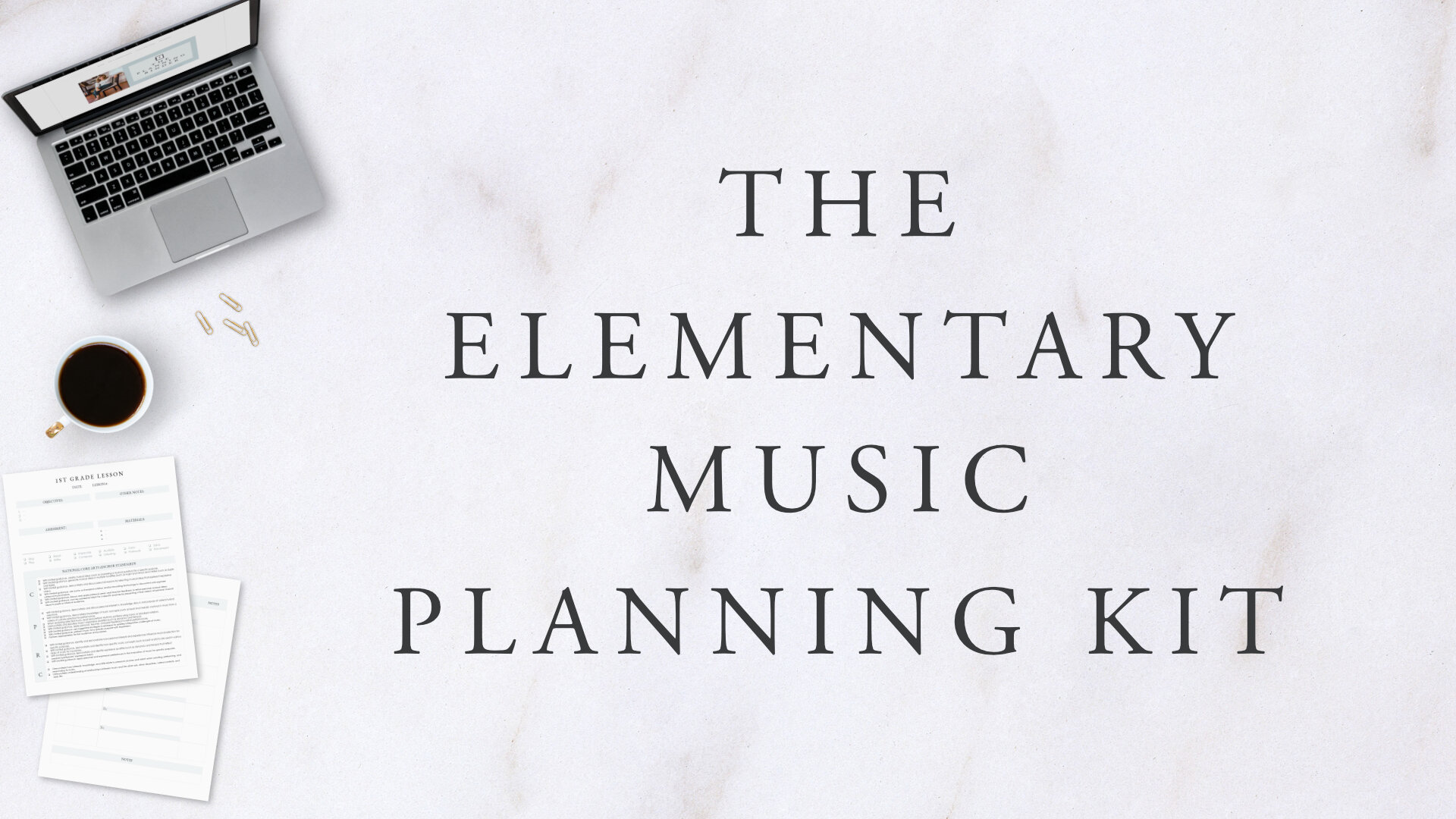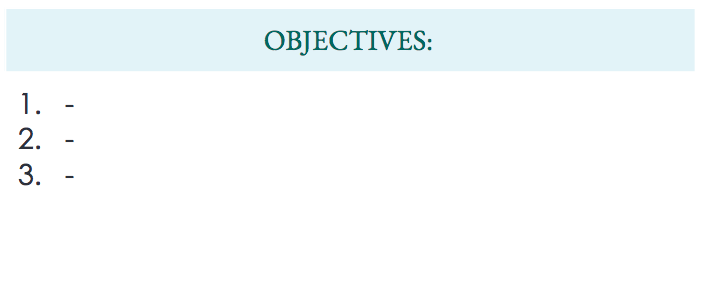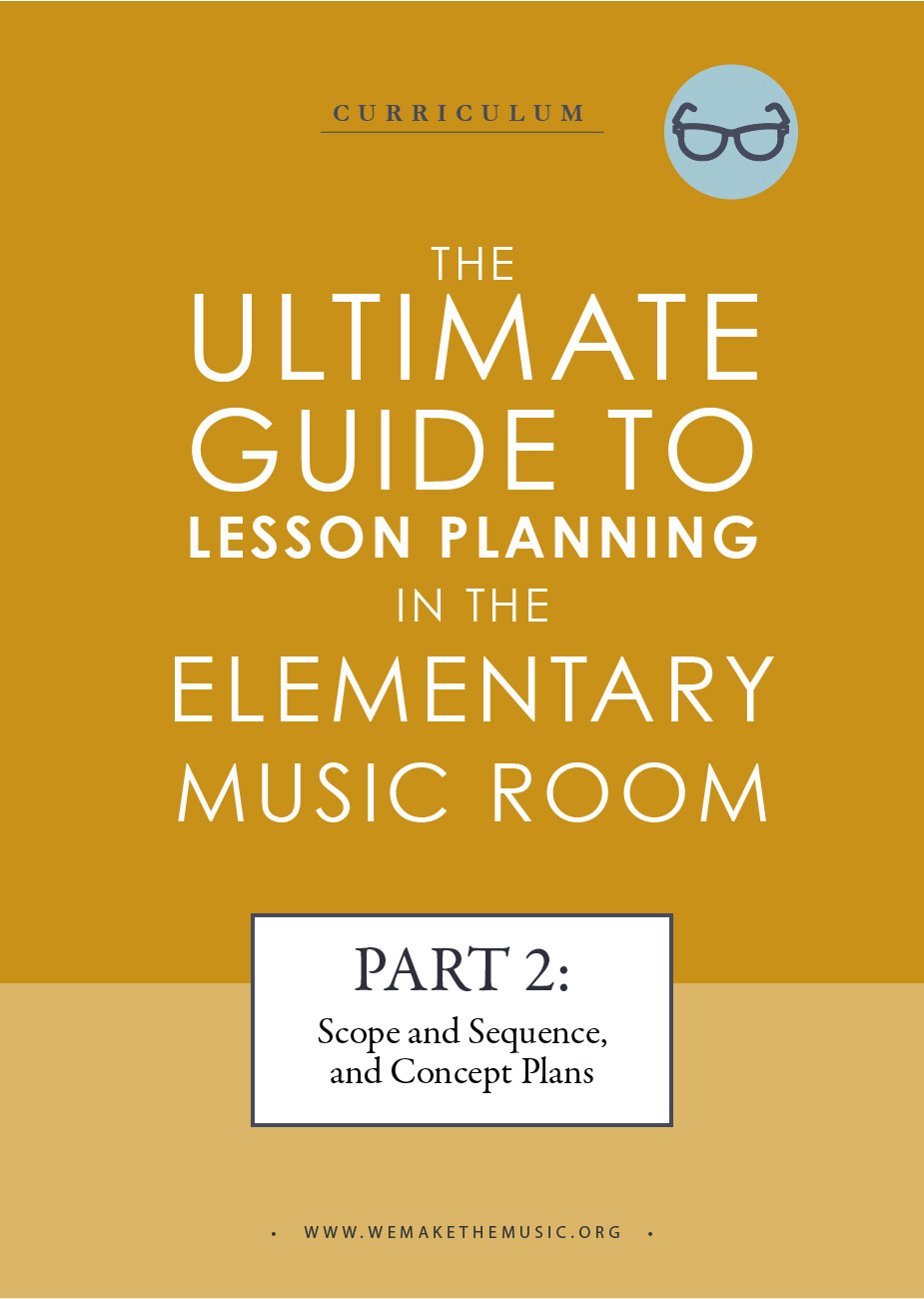When lesson plans are built on solid and purposeful teaching strategies, they are quick and painless to write! They are simply the implementation of all the ideas, strategies, and sequences you’ve documented over the planning process.
Be sure to read the first and second parts of this series where we look at how to map out a long-range plan for your music room.
Now we're on to the final step of the planning process: daily lesson plans.
Psst - On the go? Listen to this post instead of reading!
The image below is the planning template I use to create all my lessons.
It includes everything I need from standards to assessments, and since it's a google doc I can edit and access it from anywhere.
It's available to purchase here as part of a larger planning kit, or you can easily create your own from scratch!
Parts of a Lesson Plan:
The first page of this lesson template invites you to think through exactly what your intentions are, so you get a quality, purposeful lesson plan every time! If you take a look at the first page of the lesson planning template, you'll see several important components to include.
Let's break each of them down.
Lesson Objectives: These are easily measured, action-oriented, and student-centered goals for the lesson. Avoid phrases like “the student will learn about”, or “the student will understand”. Instead, focus on action verbs: “the student will improvise”, or “the student will sing”.
Assessments: How will you know students have completed your lesson objectives? Keep assessments informative for you, and fun for your students. Each lesson should have some (simple) way for you to measure students’ understanding and skill level. You can read more about assessment in the music room here.
Materials: What materials will you need for the lesson? Puppets? Instruments? Often I need to prepare materials from scratch such as smartboard presentations or visuals. This section of the lesson plan keeps me on track so I remember what materials to set out before a class arrives, or what materials to create.
Other Notes: This is the “catch all” section. If you have one class behind the others, if you’re being observed that day, if you have a student who needs special accommodations, this is the place to document it.
Skills and Standards: What skills are your students using in your lesson? Make a note of how you are asking students to interact with musical concepts. In the planning kit template I’ve only listed the National Core Arts Anchor Standards for simplicity. They can easily be substituted for your state standards in the google doc.
IF YOU'RE MAKING PAGE 1 FROM SCRATCH:
If you're making your lesson planning template from scratch instead of purchasing the planning kit, start by listing the grade, date, and lesson number at the top of the page.
Then, list out the following components of a lesson plan: objectives, assessments, materials, notes, standards, and skills. Leave room under each category to make your notes.
Writing the Lesson:
The second page of the lesson plan is where the actual teaching process lives. It's the section you'll refer to most when you're in the classroom teaching.
When it comes to writing the lesson outline, refer back to your scope and sequence for the lesson focus, and your concept plan for teaching strategies. This is where all the hard work pays off! Plug in the activity and flesh out the process. Tweak anything you need to from the original concept plan.
Lesson Planning Tips for Music Teachers:
1. Pacing:
It’s a good rule of thumb to keep each activity fairly short (think of the attention span of your students!), and to alternate between times of high concentration and relaxation. This structure keeps your pacing quick so students stay engaged.
2. Transitions:
Pay attention to how you plan to move from one activity to the next (transitions), as this is where the bulk of classroom management problems arise.
Transitions are used for entering and exiting the music room, changing from one song or activity to the next, setting up for a game, and moving to instruments.
Here are a few transition categories to get you started:
Verbal / Textual: These are the most common in younger grades. Students love stories, so connect activities with a narrative if you can. Example: After students play the game to Apple Tree, suggest that you take an apple to your friend, Johnny, who is hungry after all his hard work building a house. Then sing Johnny Works with One Hammer.
Musical (Melodic): Use identical melodic phrases to transition to a new song (such as Lucy Locket and We are Dancing in the Forest). The class sings the phrase on solfege, then the teacher asks, “What other song could this be?” Students guess from a list of songs on the board.
Musical (Rhythmic): Read a rhythmic phrase of a song written on the board. The teacher changes one note at a time until the rhythm becomes the beginning of the next song.
Nonverbal: Our students have to sort through a staggering amount of verbal information in a typical school day. A nonverbal transition can be a refreshing change for both you and your class! Use sign language for sit and stand; Use pictures of game formations such as concentric circles, longways set
Movement: We Orff inspired teachers are always looking to add more movement to our lessons! Have students glide, stomp, tiptoe, slither, flounce, sneak, or jump to their next location.
IF YOU'RE MAKING PAGE 2 FROM SCRATCH:
If you're making the lesson outline from scratch, create a table four columns across and about six to eight rows down. The actual number will depend on how many songs you choose to include in your lesson.
From there, record the time of each activity, the song you'll use, a detailed teaching process, and any special notes or considerations to keep in mind.
There you have it!
Daily lesson planning can be a breeze when you've done the right long-range planning beforehand.
You can grab the planning kit to help make your year planning smooth, or create your own templates from scratch by following the process in these blog posts:
Yearly Music Planning Tip:
It’s okay to adapt as you go! You can’t anticipate everything that will happen over the course of the school year and how your plan will need to change to fit your unique teaching situation. Drop any activities that don’t serve you or your students, and let go of any pressure you feel to implement your yearly plan exactly as you wrote it.



















